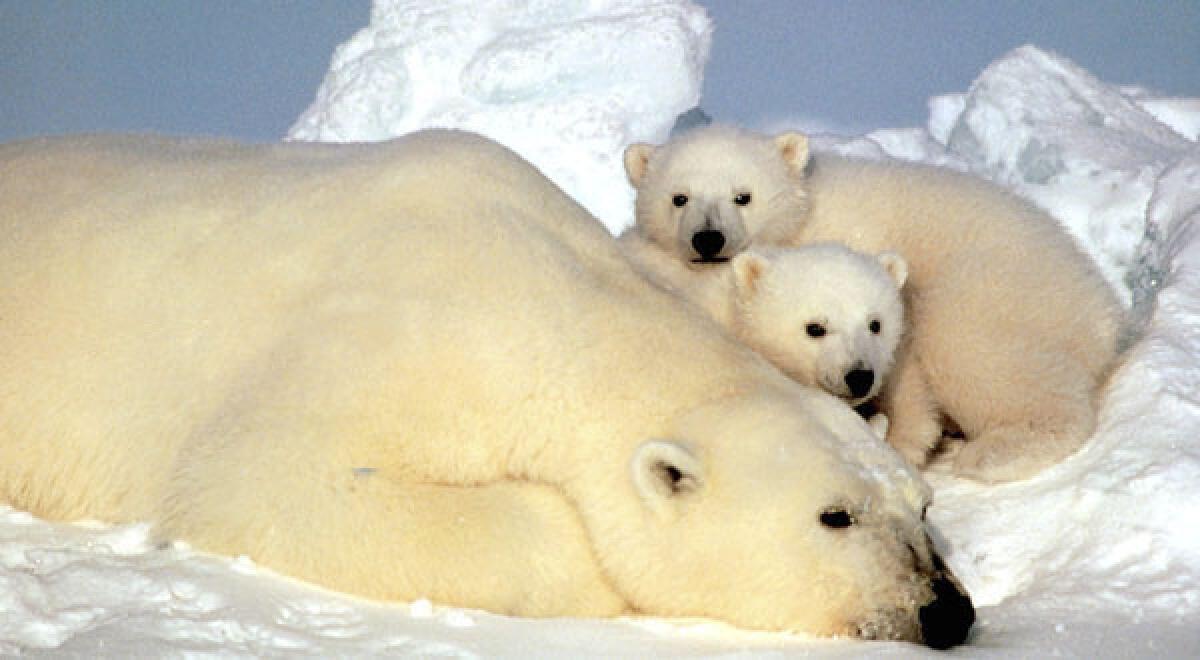Federal court upholds polar bear status as threatened species

SEATTLE — The federal law listing polar bears as a threatened species was upheld Friday by a federal appeals court, which rejected arguments that it is wrong to impose far-ranging and possibly costly protections for a species that remains fairly abundant in many regions of the Arctic.
Concluding that attacks on the listing “amount to nothing more than competing views on policy and science,” the U.S. Circuit Court of Appeals in Washington, D.C., upheld the U.S. Fish and Wildlife Service’s 2008 decision to protect the animals because the dramatic loss of sea ice leaves them likely to become in danger of extinction.
There are still about 25,000 polar bears around the world, many of them in relatively healthy populations, but scientists fear that climate change is rapidly affecting their ability to sustain those numbers after the next half-century.
Polar bears depend on sea ice as a platform for hunting and often use it for denning. Its loss near the productive, shallow waters close to shore could soon leave the animals in danger of steep decline, federal authorities concluded in their listing decision, which was upheld by the court.
The issue has been highly controversial, particularly in Alaska, where polar bears live side by side with the state’s powerful oil and gas industry. The animal’s protection under the Endangered Species Act means much more formidable hurdles for obtaining oil drilling permits, especially as offshore operations expand into the Beaufort and Chukchi seas.
“There are two competing visions of the future of Alaska,” the Alaska Department of Law said when it filed its brief in the case. “Ours is one in which responsible resource development proceeds apace and protections remain in place for wildlife, including polar bears, which we treasure. The other vision is one in which Alaska’s resources are locked up, our economy languishes, we lose population and we lack the capacity to maintain schools, roads, bridges, harbors and airports.... It is imperative that this latter vision does not become a reality.”
The state, along with the international hunting group Safari Club International, argued that the Fish and Wildlife Service should have taken into account the fact that polar bear populations are healthy in some places, especially in northeast Canada, where steps are being taken to boost their numbers that could negate the dire forecasts.
“For the first time under the ESA, the service … listed a species based on uncertain predictions for future threats of habitat loss, rather than on actual observed population declines or sufficiently likely threats,” the appellants said in their brief. “Moreover, this listing represents the first time the service has listed a species that is at an all-time historical high in population numbers … and is listed solely because of forecasted future trends.”
The appeals court found that the government had established broad scientific agreement that the species’ numbers indeed are headed into a downward spiral and said the agency also met its other procedural requirements for designating a “threatened” status.
Conservationists had initially sued to force the agency to go even further and consider polar bears fully endangered, but they lost that fight in the district court and didn’t appeal.
Kassie Siegel of the Center for Biological Diversity, which originally petitioned to have polar bears listed, said there is little likelihood of a successful appeal. “So for practical purposes, the listing of the polar bear is final, and really no longer under any serious threat from these challenges,” she said.
Still, environmental groups say they are frustrated that the Fish and Wildlife Service has exempted greenhouse gases from consideration as one of the prohibited threats to polar bears, now that they are protected. That was accomplished by a special rule that considers only those threats that occur within the polar bear’s range, not, for example, coal-fired power plants in the continental U.S.
“Beyond this ruling, we also think it’s important that we get serious about dealing with climate change and address the other threats to the species, like over-hunting and toxic contamination,” added Rebecca Riley, an attorney for the Natural Resources Defense Council.
ALSO:
For Hollywood’s sake, N.Y. may tweak its assault weapons ban
‘Lake Michigan marbles’ -- ice boulders that have people talking
Florida man presumed dead after sinkhole swallows his bedroom
More to Read
Start your day right
Sign up for Essential California for news, features and recommendations from the L.A. Times and beyond in your inbox six days a week.
You may occasionally receive promotional content from the Los Angeles Times.






